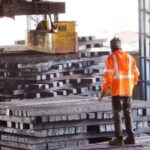Difference Between TMT, HYSD, and TOR Steel Bars
TMT: Thermo Mechanically Treated or TMT bars are high-strength reinforcement bars having a hardened outer core and a soft inner core. They are manufactured under a process called Thermo Mechanical Treatment, after which they are named.They are manufactured by passing hot rolled steel billets through water, which hardens the surface and increases its tensile strength while the inner core stays at a comparatively warmer temperature and hence, the core becomes more ductile. This variation in the microstructure of the cross-section of the bar provides huge strength to the bar. Since there are no twisting or deformation processes employed in this method, TMT bars have no surface cracks or other defects as well.
HYSD: When expanded, HYSD stands for High Yielding Strength Deformed Steel; and is also their main characteristic. HYSD steel also undergoes heat treatment similar to TMT bars, but the subsequent processes are different. In this type of steel, after undergoing the heat treatment process, the hot steel rods are either heat rolled or cold twisted for shaping, thus making them both thermally and mechanically treated.
TOR: The technical term for TOR (Toristeg Steel Corporation of Luxembourg) is CTD, which when expanded, stands for Cold Twisted Deformed steel. It is a form of HYSD steel, where the steel bars, after undergoing the mandatory heat treatment process, are cold twisted and deformed. These deformations are present on the surface and are done after an elongation process, which imparts higher yield strength to steel and the surface deformations impart higher bondage with concrete. Because of the deformations, these bars minimize slippage in concrete and increases the bond between the two materials. Deformed bars have a higher tensile strength than that of MS steel bars and the deformations should be uniformly spaced along the length of the bar.
Both TOR and TMT bars have almost comparable iron content, so both of them exhibit high strength, albeit TMT bars are significantly stronger. Also, due to the superiority in the strength of TMT bars and also because of its higher corrosive resistance, TMT bars are better suited for use in large concrete structures and concrete structures built on the coastlines where high humidity is a major issue. On the flip side of the coin, TOR bars are general-purpose steel bars used in buildings, roads, and bridges as they surpass the minimum strength requirements.
To sum it all up in short, the basic difference between TMT, HYSD, and TOR steel bars is the manufacturing process – TMT bars are subjected to water quenching whereas HYSD and TOR are subjected to heat rolling or cold twisting.
9 Reasons Why You Must Opt for TMT bars over HYSD and TOR steel:
- Due to the ductile microstructure and a hard crystalline exterior surface of TMT bars, TMT bars have a stronger external layer as compared to HYSD steel bars.
- TMT bars have less residual stresses and higher tensile strength than HYSD bars because TMT bars do not undergo any physical deformation, unlike HYSD bars.
- As TMT bars do not undergo any physical deformation (twisting), no torsional stress occurs which removes the chances of surface defects in TMT bars.
- Due to the reduced amount of surface defects in TMT bars as compared to HYSD steel, they are comparatively much less susceptible to the harmful effects of oxidation like corrosion.
- TMT bars do not require explicit hardening as the hardening process is conveniently achieved by the water quenching process, thus reducing the energy and expenditure required for physically deforming the steel bars, and hence increasing their affordability.
- Due to the amazing flexibility and durability exhibited by TMT bars, they can be used for a wide range of construction works and is basically one of the primary reasons why construction workers rely a lot more on TMT bars as compared to HYSD steel bars.
- Using TMT bars for construction helps to reduce the consumption of steel by 8% to 11% as compared to HYSD bars for the same construction, again increasing their affordability.
- As TMT bars have a uniform and hardened periphery and a considerably softer core, this kind of bars will have the desired tensile strengths coupled with high elongation and ductility as required in the construction of buildings located in areas with regular seismic activity.
- TMT bars provide a longer life to the structures where they are used. The TMT steel inside the concrete does not react with the moisture in the surroundings. This reaction when allowed to occur results in the formation of rust which acts like cancer and results in cracks in the concrete, thus weakening the structure and subsequently shortening the lifespan of structures and buildings.
The above reasons clearly illustrate the difference between TMT, HYSD, and TOR steel bars and make it clear why it is beneficial for the customers to opt for TMT bars over the latter variants.



